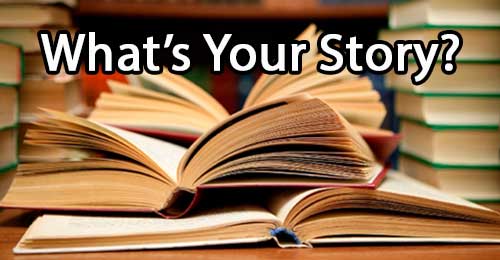November is National Family Stories Month – and with the weather getting cold, it’s a perfect time for curling up in front of the woodstove and telling stories. Though, of course, any time of year is good for family stories – on the porch, at the dinner table, around the campfire – and the more the better. See below for some of the many ways in which other people have told theirs.
What about playing family story-telling games, making your own family memory book, creating a family name quilt, or keeping a cartoon diary?
Table of Contents
TRUE FAMILY STORIES
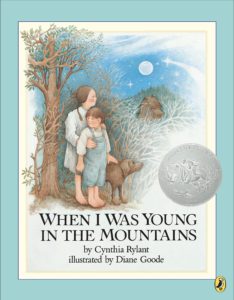
|
Cynthia Rylant’s When I Was Young in the Mountains (Puffin, 1993), a Caldecott Honor Book, is an evocative first-person account of a West Virginia childhood that begins “When I was young in the mountains, Grandfather came home in the evening covered with the black dust of a coal mine.” For ages 5-8. |
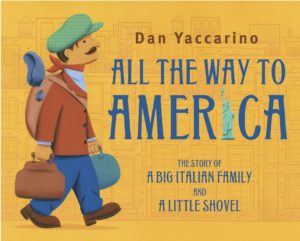
|
Dan Yaccarino’s All the Way to America (Dragonfly, 2014) – subtitled “The Story of a Big Italian Family and a Little Shovel” – traces his family history from Sorrento, Italy, where his great-grandfather, Michele, was given a little shovel by his father so that he could help tend the family garden plot. When, as a young man, Michele leaves for America, he takes the little shovel with him, along with some family photographs and his mother’s recipe for tomato sauce. Eventually, the little shovel is passed down through generations. (The author picture on the back flap shows Yaccarino holding it.) For ages 5-9. |
| For more resources, see Immigrants and Refugees. | |
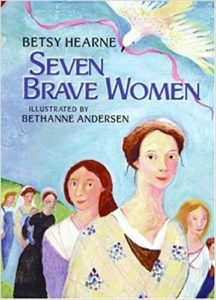
|
Betsy Hearne’s picture book Seven Brave Women (Greenwillow Books, 2006) traces her family history through seven generations, beginning with great-great-great-grandmother Elizabeth, who came to America from Switzerland in a wooden boat, and great-great-grandmother Eliza, who traveled west to Ohio in a covered wagon. For ages 5-9. |
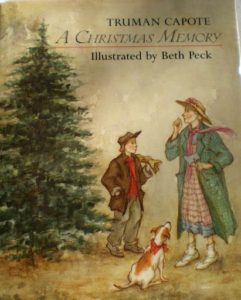
|
Truman Capote’s A Christmas Memory (Knopf Books for Young Readers, 2006) is a wonderful account of Capote’s (as “Buddy”) childhood in rural Alabama in the 1930s and his friendship with his eccentric Aunt Sook. Aunt Sook is also featured in The Thanksgiving Visitor, in which she invites Buddy’s nemesis, the school bully Odd Henderson, to Thanksgiving dinner. For ages 6 and up. |
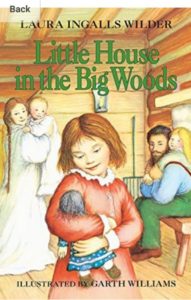
|
The nine-book Little House series by Laura Ingalls Wilder, beginning with Little House in the Big Woods (HarperCollins, 2004), collectively tells the story of the life of Laura and her family as pioneers in the mid-19th century. Filled with details, adventures, and Pa’s fiddle music. For ages 7 and up. |
| From the New Yorker, Judith Thurman’s Wilder Women is an interesting account of Laura Ingalls Wilder, her daughter Rose, and their now-classic books. | |
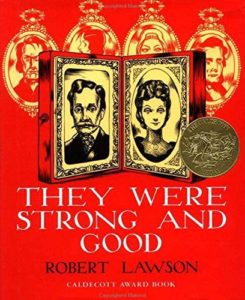
|
Robert Lawson’s They Were Strong and Good (Viking Juvenile Books, 2006) traces his family’s journey through American history, beginning with his grandparents: “My mother’s father was a Scotch sea captain. He sailed the brig Eliza Jane Hopper from New York to the islands of the Caribbean – to Puerto Rico and Cuba and the Isthmus of Panama.” For ages 8-12. |
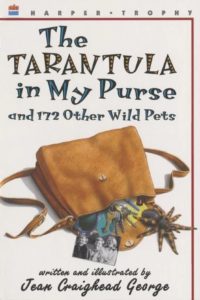 |
Jean Craighead George’s The Tarantula in My Purse and 172 Other Wild Pets (HarperCollins, 1997) is the story of George’s family life with orphaned wild animals, among them Yammer, an owl who liked to watch Road Runner cartoons, and Duck and Goose, who were arrested for disturbing the peace. For ages 8-12. |
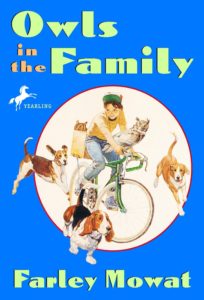 |
Farley Mowat’s Owls in the Family (Yearling, 1996) is the story of his childhood on the Canadian prairie, along with his obstreperous and endearing pet owls, Wol and Weeps. For ages 8-12. |
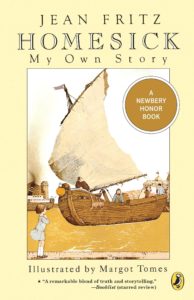 |
Jean Fritz’s Homesick, My Own Story (Puffin, 1999) is the fascinating story of Fritz’s childhood in China in the 1920s. For ages 8 and up. |
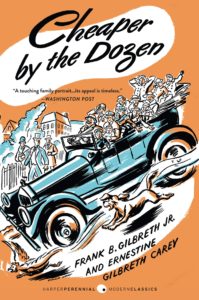 |
Cheaper by the Dozen by Frank B. Gilbreth and Ernestine Gilbreth Carey (HarperCollins, 2005) is both a wonderful collection of family stories and a great family read-aloud. Originally published in the 1940s, this is the story of the Gilbreth family as told by two of the kids. The Gilbreth parents were early efficiency experts, who combined research with a boisterous family of twelve redheads. (Learn about Dad’s disastrous birdbath, the perils of automobiles, home-style tonsillectomies, and how to take a bath in under a minute.) For ages 9 and up. |
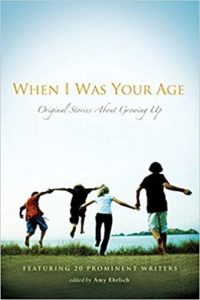
|
When I Was Your Age, edited by Amy Ehrlich, (Candlewick Press, 2012) is a collection of childhood reminiscences by ten well-known children’s book authors, among them Mary Pope Osborne, Katherine Paterson, Avi, James Howe, and Susan Cooper. (If you and your kids like that, there’s a sequel: When I Was Your Age, Volume 2.) For ages 9-14. |
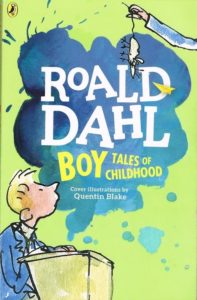 |
Roald Dahl’s Boy (Puffin, 2009), illustrated with photos and drawings by Quentin Blake, is Dahl’s account of his boyhood, including the wicked tale of the Great Mouse Plot of 1924. (It involves a dead mouse and candy.) For ages 9-14. |
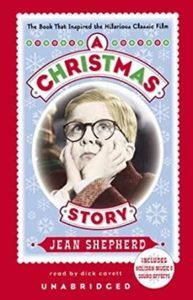
|
Jean Shepherd’s A Christmas Story (Broadway, 2003) is the hilarious tale of Shepherd’s Indiana boyhood, featuring a secret decoder ring (that proves to advertise Ovaltine), a scandalous leg lamp (wearing a fishnet stocking), the tobacco-chewing Bumpuses next door with their swarm of hideous hounds, and young Ralphie’s hope for a Red Ryder B-B gun for Christmas. For ages 10 and up. |
| The 1983 film version of A Christmas Story – which is funny and terrific – is rated PG. | |
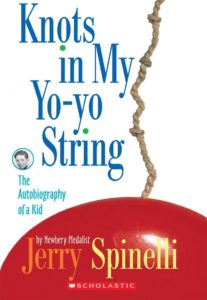 |
Jerry Spinelli’s Knots in My Yo-Yo String (Ember, 1998) is the story of Spinelli’s youth in Norristown, Pennsylvania, in the 1950s. For ages 10-13. |
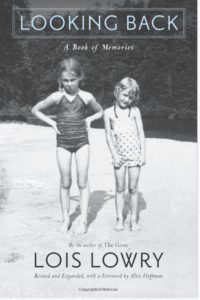
|
Lois Lowry’s Looking Back: A Book of Memories (Delacorte Books for Young Readers, 2000) is a marvelous collection of autobiographical stories accompanied by black-and-white photos, each showing how Lowry used her personal life experiences in her many novels. (Each chapter opens with a novel excerpt.) For ages 11 and up. |
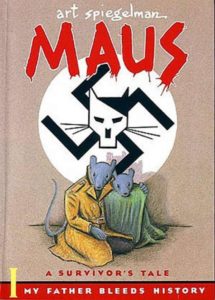 |
Art Spiegelman’s powerful graphic novels Maus (Pantheon, 1986) and Maus II tell the story of his parents’ experiences in Nazi-occupied Poland and post-war life in the United States. For ages 13 and up. |
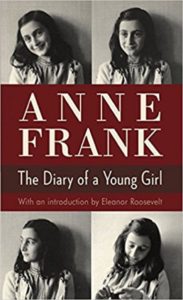 |
Anne Frank’s The Diary of a Young Girl (Bantam, 1993) is a world classic. The diary begins when Anne was 13, just before she and her family go into hiding in the “secret annex” in Nazi-occupied Amsterdam. For ages 13 and up. |
| See the Anne Frank website for period photos of Anne’s Amsterdam, a tour of the secret annex, information on the diary, and more. | |
| For more resources, see The Holocaust. | |
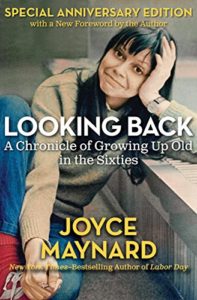 |
Joyce Maynard’s Looking Back (Open Road, 2012), a memoir written when Maynard was 18, is “A Chronicle of Growing Up Old in the Sixties.” For ages 13 and up. |
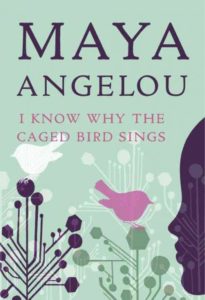 |
Maya Angelou’s I Know Why the Caged Bird Sings (Ballantine, 2009) is the wonderful, painful, and uplifting story of the poet’s youth, her struggles to overcome bigotry and deal with physical and emotional hardship, and her ultimate discovery of her own strength and her love for the written word. For teenagers and adults. |
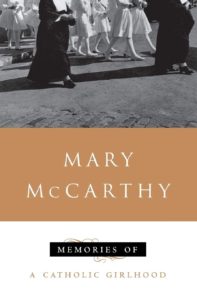 |
Mary McCarthy’s Memories of a Catholic Girlhood (Mariner Books, 1972) is a superb collection of autobiographical pieces beginning after the author’s parents died in the influenza epidemic of 1918. For older teenagers and adults. |
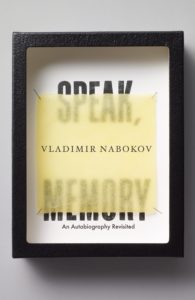 |
Vladimir Nabokov’s Speak, Memory (Vintage, 1989) is a stunning autobiography, dealing primarily with Nabokov’s life in Russia before coming to the United States. For teenagers and adults. |
| Not fond of memoirs? See The Problem With Memoirs from the New York Times. It begins ” A moment of silence, please, for the lost art of shutting up.” |
